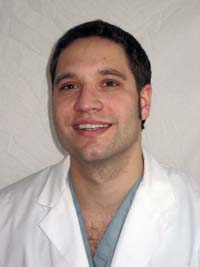Dr. Harald C. Ott
The PhysOrg article Researchers create beating heart in laboratory said
University of Minnesota researchers have created a beating heart in the laboratory. By using a process called whole organ decellularization, scientists from the University of Minnesota Center for Cardiovascular Repair grew functioning heart tissue by taking dead rat and pig hearts and reseeding them with a mixture of live cells.
“We just took nature’s own building blocks to build a new organ,” said Harald C. Ott, M.D., co-investigator of the study and a former research associate in the center for cardiovascular repair, who now works at Massachusetts General Hospital. “When we saw the first contractions we were speechless.”
Researchers are optimistic this discovery could help increase the donor organ pool.
Harald C. Ott, M.D. is at Massachusetts General Hospital, Harvard
Medical
School, and his interests are cardiac cell therapy and cardiac tissue
engineering.
Harald authored and coauthored several research publications in the
field of
cardiac repair/regeneration and robotic surgery. He received multiple
scientific awards, among those the Young Investigator Award of the
European
Association of Cardio-Thoracic Surgery in 2003, and the Theodor-Billroth
Award of the Austrian Society of Surgery in 2005.
In 2004,
he introduced
the
concept of combined cell therapy to cellular cardiomyoplasty
(Combined
transplantation of skeletal myoblasts and bone marrow stem cells for
myocardial repair in rats) and worked on a better understanding
of the
mechanism underlying cardiac cell therapy (On the fate of skeletal
myoblasts
in a cardiac environment: down-regulation of voltage-gated ion
channels).
In 2005, his focus began to shift to alternative cell types such as
cardiac
derived stem cells (Cell therapy for heart failure – muscle, bone
marrow,
blood, and cardiac-derived stem cells,
From cardiac repair to cardiac
regeneration – ready to translate?, and
The adult human heart as
a
source
for stem cells: repair strategies with embryonic-like progenitor
cells),
and
to cardiac tissue engineering
(Perfusion-decellularized matrix: using
nature’s platform to engineer a bioartificial
heart).
In a more
translational focus, Harald worked on improving methods for cell
delivery
(Intramyocardial microdepot injection increases the efficacy of
skeletal
myoblast transplantation) and robotic surgery in an attempt to
provide
less
invasive surgical techniques
(Robotic-Assisted Thoracoscopic Surgery
(RATS)
for Benign and Malignant Esophageal Tumors and
Robotic minimally invasive
cell
transplantation for heart failure).
As cardiac and
vascular
disease have
many overlapping pathways, atherosclerosis has always been another
research
focus, mostly in collaborative efforts
(Perivascular application of
C-type
natriuretic peptide attenuates neointimal hyperplasia in experimental
vein
grafts,
Rapamycin treatment is associated with an increased
apoptosis
rate
in experimental vein grafts, and
Sex-dependent attenuation of plaque
growth
after treatment with bone marrow mononuclear cells). Since 2004,
Harald
has
been consulting scientist for the 6th and 7th Framework Program, EU and
since 2007 for the European Research Council, ERC.
Harald earned his M.D. at the University of Innsbruck, Medical School,
Austria in 2000. He began his CT Residency at the University of
Innsbruck,
Department of Surgery in 2004. At the same time, he began to focus on
cardiac repair and regeneration. He did basic research at the University
of
Minnesota, Center for Cardiovascular Repair from 2004 to 2006, and began
his
General Surgical Residency at Massachusetts General Hospital, Harvard
Medical School in 2006.





